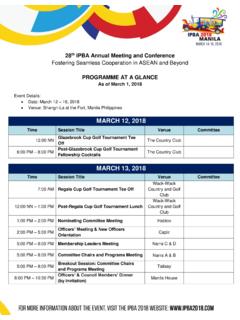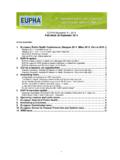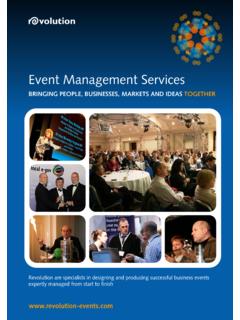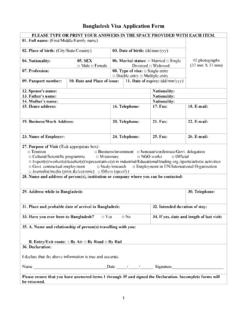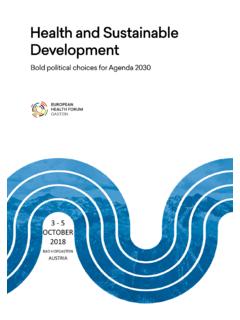Transcription of Program theory and logic models for systemic evaluation
1 Program theory and logic models for systemic evaluation International conference on systemic Approaches in evaluation Deutsche Gesellschaft f r Internationale Zusammenarbeit (GIZ). Eschborn, Germany 25-26 January 2011. Patricia Rogers Overview Presentation: Simple, complicated and complex systems 7 aspects to consider for evaluation Examples How these aspects have been addressed in some recent examples of Program theory Discussion What recommendations of practical relevance can be made? How to develop it further? How to create the preconditions for systemic evaluations (if it is considered desirable). Recommendations for Evaluators Managers of evaluations Donors 2. Sources for this presentation 3.
2 Some definitions Program theory An explicit theory of how an intervention contributes to the intended or observed outcomes, which has 2 components: theory of The process by which change comes about (for an change individual, organization or community). theory of action How the intervention is constructed to activate the theory of change logic model A visual representation of a Program theory , usually in a diagram but sometimes in a table Program theory An evaluation that is at least partly guided by an explicit evaluation Program theory . It is not necessarily driven by the theory , since it should be driven by its intended purpose and the needs of its intended users Funnell and Rogers Purposeful Program theory 4.
3 What people sometimes assume you mean by logic models that address complexity Funnell and Rogers Purposeful Program theory 5. Two framings of simple, complicated and complex Glouberman and Zimmerman 2002 Kurtz and Snowden 2003. Simple Tested recipes assure The domain of the known , replicability Cause and effect are well Expertise is not needed understood, Best practices can be confidently recommended, Complicated Success requires high level of The domain of the knowable . expertise in many specialized Expert knowledge is required, fields + coordination Complex Every situation is unique The domain of the unknowable , previous success does not Patterns are only evident in guarantee success retrospect.
4 Expertise can help but is not sufficient; relationships are key Glouberman, S., and Zimmerman, B. Complicated and Complex Systems: What Would Successful Reform of Medicare Look Like? Ottawa: Commission on the Future of Health Care in Canada, 2002. Kurtz, C. F. and D. J. Snowden (2003) The New Dynamics of Strategy: Sense-making in a Complex and Complicated World , IBM. Systems Journal 42(3): 462 83. ( who also discuss chaotic and disordered). 6. Different types of systems A simple system A complicated system A complex system 1. 2 .Heath Robinson 3. Oriolus 7. What constitutes a systemic approach to evaluation ? Attention to: Inter-relationships Perspectives Boundaries Williams B.
5 Imam I. (2007) (eds) Systems Concepts in evaluation - An Expert Anthology EdgePress/AEA Point Reyes CA. Williams, B and Hummelbrunner, R (2010) Systems Concepts In Action: A Practitioner's Toolkit . Stanford: Stanford University Press. 8. Aspects of complicated and complex situations and interventions with potentially important implications for evaluation 1) Focus 2) Governance 3) Consistency 4) Necessariness 5) Sufficiency 6) Change trajectory 7) Unintended outcomes Funnell, and Rogers, (2011) Purposeful Program theory . San Francisco: Jossey-Bass/Wiley. 9. (1) Focus Simple Single set of intended outcomes/impacts Complicated Different intended outcomes/impacts intended by different partners/stakeholders Different intended outcomes/impacts at different levels Complex Emergent intended outcomes/impacts 10.
6 Simple focus Intervention that produces single set of outcomes Intervention Shorter term Longer term outcomes outcomes 11. Complicated focus (1). Intervention that produces different outcomes valued by different stakeholders INTERVENTION SHORT-TERM LONG-TERM. OUTCOMES OUTCOMES. DIFFERENT. LONG-TERM. OUTCOMES. 12. Complicated focus (2). Intervention that produces different outcomes at different levels Intervention Longer term Activities at Shorter term outcomes at outcomes system level system level Activities at site level Shorter term outcomes at site level Activities at client level Shorter term outcomes at client level 13. Complex focus (1). Intervention that produces emergent intermediate outcomes Funnell and Rogers Purposeful Program theory 14.
7 Complex focus (2). Intervention that produces emergent long-term outcomes Funnell and Rogers Purposeful Program theory 15. (2) Governance Simple Single organization Complicated Specific organizations with formalized requirements Complex Emergent organizations working together in flexible ways Funnell and Rogers Purposeful Program theory 16. (3) Consistency Simple Implement what has been identified as best practice or evidence-based practice what works Complicated Classify the situation and implement what has been adapted for that context what works for whom in what situation Complex Ongoing adaptation to emerging conditions what is working here 17. Complex consistency Adaptive, responsive intervention SHORT-TERM LONG-TERM.
8 INTERVENTION OUTCOMES OUTCOMES. 18. (4) Necessariness Simple Only way to achieve the intended impacts Complicated One of several ways to achieve the intended impacts which can be identified in advance Complex One of several ways to achieve the intended impacts which are only evident in retrospect Funnell and Rogers Purposeful Program theory 19. (5) Sufficiency Simple Sufficient to produce the intended impacts. Works the same for everyone Complicated Only works in conjunction with other interventions (previously, concurrently, or subsequently) and/or only works for some people and/or only works in some circumstances which can be identified in advance Complex Only works in conjunction with other interventions (previously, concurrently, or subsequently) and/or only works for some people and/or only works in some circumstances which is only evident in retrospect Funnell and Rogers 2010 Purposeful Program theory .
9 Jossey-Bass). Funnell and Rogers Purposeful Program theory 20. Ways in which an intervention can work with other interventions Stronger Families and Communities Strategy evaluation 2000-2004 Final Report Funnell and Rogers Purposeful Program theory 21. Complicated necessariness (1). Multi-stage intervention (eg Outcome Mapping). Intervention Shorter term outcomes A different Longer term intervention outcomes Funnell and Rogers Purposeful Program theory 22. Complicated necessariness (2). Intervention that works in combination with other interventions INTERVENTION SHORT-TERM OUTCOMES/. OUTCOMES IMPACTS. ANOTHER SHORT-TERM. INTERVENTION OUTCOMES. ANOTHER SHORT-TERM. INTERVENTION OUTCOMES.
10 Funnell and Rogers Purposeful Program theory 23. Complicated necessariness (3). Intervention that works differently for different types of participants INTERVENTION SHORT-TERM LONG-TERM. OUTCOMES OUTCOMES. PARTICULAR. PARTICIPANT. CHARACTERISTICS. INTERVENTION. DIFFERENT DIFFERENT. SHORT-TERM LONG-TERM. OUTCOMES OUTCOMES. DIFFERENT. PARTICIPANT. CHARACTERISTICS. Funnell and Rogers Purposeful Program theory 24. (6) Change trajectory Simple Constant, linear relationship between effort and results (eg twice the investment produces twice the results). Complicated Well understood but not linear relationship between effort and results (eg curvilinear dose-response relationship such as diminishing returns or too much of a good thing).
